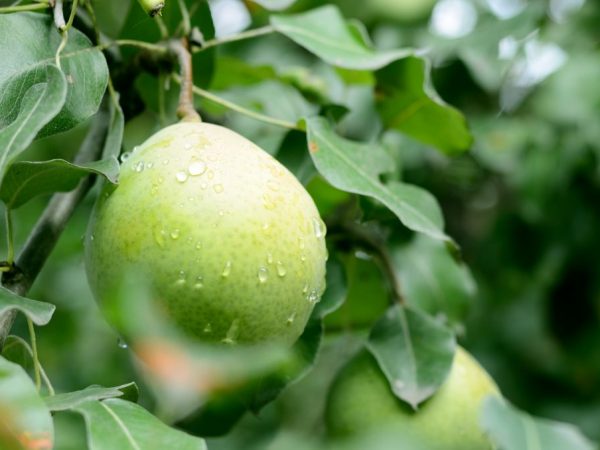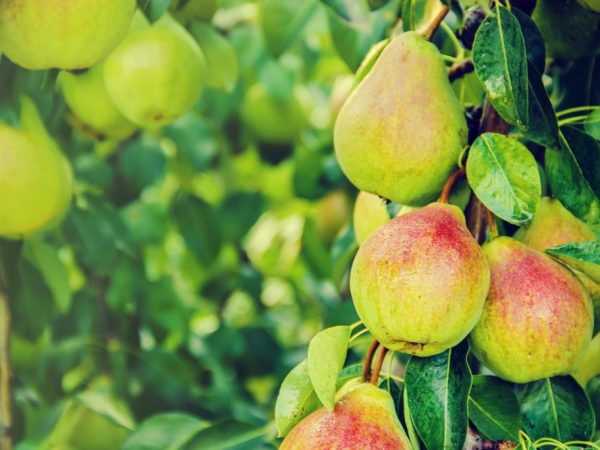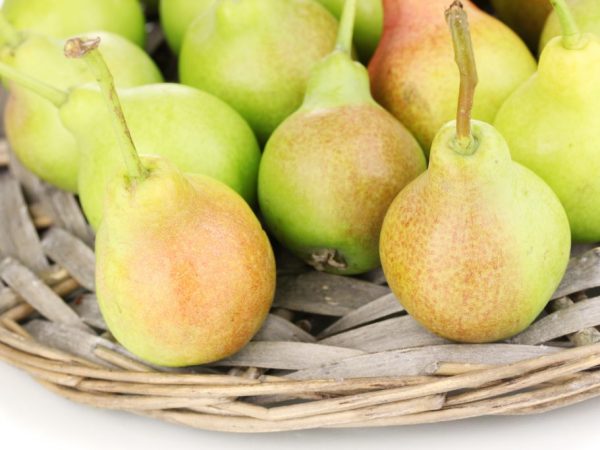Characteristics of Rogneda variety pear
The Rogneda pear is an early variety. Obtained by crossing such varieties as Tema and Lesnaya Krasavitsa. Due to its characteristics, it is perfect for the middle lane. The Rogneda pear variety has earned its popularity in the Kaluga and Moscow regions. We will consider a detailed description of the variety in the article.

Characteristics of Rogneda variety pear
Characteristics of the variety
The Rogneda variety is partially self-fertile. With proper care, it will bear its first fruits in early autumn 3-4 years after planting. Harvesting can be done at the end of August - beginning of September. It is very important not to miss this moment, as the fruit very quickly overripe and fall off. You can store the harvested crop for up to 50-60 days.
The variety tolerates low temperatures well. When grown in Siberia, the Rogned pear showed itself from a very good side, and only in a few cases did the trees freeze.
Description of the tree
The trunk of the tree is medium-sized. Approximately 4 meters high.
The crown is dense, roundish in shape with an average density of leaves. Despite the weak ability to develop shoots, it has a fairly high kidney awakening.
Leaves are medium in size, have a greenish brown color. Flowering is resistant to spring temperature changes.
Description of fruits
Fruits are small in size, reaching 120 g in weight. Fresh can lie on average up to 15 days. You need to remove the fruits 10 days before they are fully ripe to avoid spoilage.

The fruits are juicy, have a pleasant aroma and sweet taste.
They have a rounded shape. The peel is light yellow at the time of ripening. Fruits located on the sunny side may develop a reddish blush.
The fruits are juicy, have a pleasant aroma and sweet taste. Pears are perfect both for eating them fresh and for preservation. Also, ripe fruits make excellent jam and compote.
Care
If you approach the care of young seedlings correctly, then in the future the trees will develop without various complications. The Rogneda pear is unpretentious, but nevertheless it needs timely feeding and protection from the variability of weather conditions.
Landing
In order to enjoy a good harvest in the future, you need to wisely approach the planting of seedlings. When choosing a soil, it is worth considering the fact that the culture does not tolerate an excessive amount of moisture in the soil. That is why, before planting seedlings, it is worth knowing the depth of the groundwater flow. This distance must be more than 3 m.
The place should be open, sunny, and well ventilated. It is advised to plant seedlings in the fall, at the beginning of October. In exceptional cases, planting can be carried out in the spring at the end of April.
The soil must contain clay or sand. A solution of lime (2 tbsp) and water (10 liters) will help reduce the acidity of the soil. The distance between the trees should be more than 2 m. The planted seedlings must be watered with 20-25 liters of water.
Watering
All pear trees, regardless of their variety, give preference to watering by sprinkling.Watering should be done 4-5 times a month, pouring about 10 liters of water under each tree. It is important not to forget about this in July and August when the tree bears fruit.

The Rogneda pear is unpretentious, but nevertheless it needs timely feeding and protection from the variability of weather conditions.
Watering this species is worth taking into account the weather conditions and soil moisture. You also need to remember about loosening the near-stem circle after each watering. This will provide the root system with sufficient air and moisture.
Pruning
Pruning trees should be done before bud break in the second year of growth. You need to choose 3-4 skeletal branches with an angle of at least 45 °, cut them by ¼ keeping the same level. The next year, the same procedure should be repeated with the previously left skeletal branches.
To achieve the correct shape of the tree, it is worth pruning from the outside of the buds. The branches of the second order are important in the growth of the tree.
Pollination
The quality of pollination depends on the length of the flower stamens and their ability to self-pollinate. But in order to provide yourself with a good harvest, you can insure yourself by planting similar varieties of pears that will play the role of pollinators.
If Rogneda is unable to self-pollinate, the late summer varieties planted in the neighborhood will cope with this task. They should also tolerate low temperatures well and have similar flowering times. Excellent pollinators can be varieties of pears such as Vidnaya, Milada and Chizhovskaya
Fertilization
Fertilization is a very important step in growing. The frequency and amount of fertilization applied is determined taking into account the growth of the tree.
When planting, it is worth adding organic fertilizers to the ground:
- Wood ash (700-800 g)
- Humus (4-5 kg)
During the digging period, you can add the following mineral fertilizers:
- phosphate rock (30-40 g)
- ammonium nitrate (15-25 g)
- superphosphate (50-60 g)
If necessary, the tree should be sprayed with urea at the rate of 50-100 grams per 10 liters of water.
Diseases and pests
Various diseases and parasites can undermine Rogneda's health and significantly reduce yields. This horticultural crop is susceptible to attack by pear and gall mites.
The pea sucker is very harmful to the branches and deciduous cover of the tree and contributes to the appearance of a sooty fungus. It forms a black bloom on fruits and leaves. Fufanon solution will provide excellent protection. It must be sprayed by dissolving 10 ml per 10 liters of water. Inta-vira is also an excellent substitute for this drug. It is used in the ratio of 1 tablet to 10 liters of water.
You can fight the gall mite by spraying the gron with a colloidal sulfur solution in proportions of 10 grams per 10 liters of water. This procedure should be repeated twice. First, when the buds are formed, and then after the tree has flowered.
The description says that the culture has a high immunity to diseases such as scab and fruit rot. But still, for preventive purposes, you can treat the tree with urea during the fall of the deciduous cover.
Conclusion
Rogneda, due to its early ripening ability, can delight its owner with tasty and juicy fruits at the end of summer. And its high frost resistance and ease of care makes it possible to grow such fruits in almost any region of the country.
Despite its unpretentiousness, this culture should be protected from various pests and diseases. And only if all these rules are observed, the yield of this fruit will be generous.


